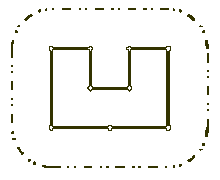hdu 1348(凸包)
Wall
Time Limit: 2000/1000 MS (Java/Others) Memory Limit: 65536/32768 K (Java/Others)
Total Submission(s): 4903 Accepted Submission(s): 1419
Problem Description
Once
upon a time there was a greedy King who ordered his chief Architect to
build a wall around the King's castle. The King was so greedy, that he
would not listen to his Architect's proposals to build a beautiful brick
wall with a perfect shape and nice tall towers. Instead, he ordered to
build the wall around the whole castle using the least amount of stone
and labor, but demanded that the wall should not come closer to the
castle than a certain distance. If the King finds that the Architect has
used more resources to build the wall than it was absolutely necessary
to satisfy those requirements, then the Architect will loose his head.
Moreover, he demanded Architect to introduce at once a plan of the wall
listing the exact amount of resources that are needed to build the wall.
Your task is to help poor Architect to save his head, by writing a program that will find the minimum possible length of the wall that he could build around the castle to satisfy King's requirements.

The task is somewhat simplified by the fact, that the King's castle has a polygonal shape and is situated on a flat ground. The Architect has already established a Cartesian coordinate system and has precisely measured the coordinates of all castle's vertices in feet.
Your task is to help poor Architect to save his head, by writing a program that will find the minimum possible length of the wall that he could build around the castle to satisfy King's requirements.

The task is somewhat simplified by the fact, that the King's castle has a polygonal shape and is situated on a flat ground. The Architect has already established a Cartesian coordinate system and has precisely measured the coordinates of all castle's vertices in feet.
Input
The
first line of the input file contains two integer numbers N and L
separated by a space. N (3 <= N <= 1000) is the number of vertices
in the King's castle, and L (1 <= L <= 1000) is the minimal
number of feet that King allows for the wall to come close to the
castle.
Next N lines describe coordinates of castle's vertices in a clockwise order. Each line contains two integer numbers Xi and Yi separated by a space (-10000 <= Xi, Yi <= 10000) that represent the coordinates of ith vertex. All vertices are different and the sides of the castle do not intersect anywhere except for vertices.
Next N lines describe coordinates of castle's vertices in a clockwise order. Each line contains two integer numbers Xi and Yi separated by a space (-10000 <= Xi, Yi <= 10000) that represent the coordinates of ith vertex. All vertices are different and the sides of the castle do not intersect anywhere except for vertices.
Output
Write
to the output file the single number that represents the minimal
possible length of the wall in feet that could be built around the
castle to satisfy King's requirements. You must present the integer
number of feet to the King, because the floating numbers are not
invented yet. However, you must round the result in such a way, that it
is accurate to 8 inches (1 foot is equal to 12 inches), since the King
will not tolerate larger error in the estimates.
This problem contains multiple test cases!
The first line of a multiple input is an integer N, then a blank line followed by N input blocks. Each input block is in the format indicated in the problem description. There is a blank line between input blocks.
The output format consists of N output blocks. There is a blank line between output blocks.
This problem contains multiple test cases!
The first line of a multiple input is an integer N, then a blank line followed by N input blocks. Each input block is in the format indicated in the problem description. There is a blank line between input blocks.
The output format consists of N output blocks. There is a blank line between output blocks.
Sample Input
1
9 100
200 400
300 400
300 300
400 300
400 400
500 400
500 200
350 200
200 200
Sample Output
1628
Source
题意:国王要在城堡外修一个外墙,这一个外墙要隔城堡至少m英尺,求修这个外墙需要的最小费用
分析:我们先要找到刚好囊括整个城堡的一个外墙,这里要利用凸包算法,然后加上一个圆的周长,这里利用的是Graham算法。下面是算法流程:
分析:我们先要找到刚好囊括整个城堡的一个外墙,这里要利用凸包算法,然后加上一个圆的周长,这里利用的是Graham算法。下面是算法流程:
令p0为Q中Y-X(not X-Y)坐标排序下最小的点
设<p1,p2,...pm>为对其余点按以p0为中心的极角逆时针排序所得的点集(如果有多个点有相同的极角,除了距p0最远的点外全部移除
压p0进栈S
压p1进栈S
压p2进栈S
for i ← 3 to m
do while 由S的栈顶元素的下一个元素、S的栈顶元素以及pi构成的折线段不拐向左侧
对S弹栈
压pi进栈S
return S;
设<p1,p2,...pm>为对其余点按以p0为中心的极角逆时针排序所得的点集(如果有多个点有相同的极角,除了距p0最远的点外全部移除
压p0进栈S
压p1进栈S
压p2进栈S
for i ← 3 to m
do while 由S的栈顶元素的下一个元素、S的栈顶元素以及pi构成的折线段不拐向左侧
对S弹栈
压pi进栈S
return S;
#include<stdio.h> #include<iostream> #include<string.h> #include<math.h> #include<algorithm> using namespace std; const int N = 1005; const double pi = atan(1.0)*4; const double eps = 1e-8; struct Point { double x,y; } p[N]; double cross(Point a,Point b,Point c) { return (a.x-c.x)*(b.y-c.y)-(b.x-c.x)*(a.y-c.y); } double dis(Point a,Point b) { return (a.x-b.x)*(a.x-b.x)+(a.y-b.y)*(a.y-b.y); } int n,m; Point Stack[N]; int cmp(Point a,Point b){ if(cross(a,b,p[0])>0) return 1; if(cross(a,b,p[0])==0&&dis(b,p[0])-dis(a,p[0])>eps) return 1; return 0; } int Graham() { int k = 0; for(int i=0; i<n; i++) { if(p[k].y>p[i].y||((p[k].y==p[i].y)&&(p[k].x>p[i].x))) k=i; } swap(p[0],p[k]); int top=2; sort(p+1,p+n,cmp); Stack[0]=p[0]; Stack[1]=p[1]; Stack[2]=p[2]; for(int i=3; i<n; i++) { while(top>=1&&cross(p[i],Stack[top],Stack[top-1])>=0) { top--; } Stack[++top]=p[i]; } return top; } int main() { int tcase; scanf("%d",&tcase); while(tcase--) { scanf("%d%d",&n,&m); for(int i=0; i<n; i++) { scanf("%lf%lf",&p[i].x,&p[i].y); } double sum=0; int top = Graham(); for(int i=1; i<=top; i++) { sum+=sqrt(dis(Stack[i],Stack[i-1])); } ///处理最后一个点和P0 sum+=sqrt(dis(Stack[0],Stack[top])); ///加上圆 sum+=2*pi*m; printf("%.0lf\n",sum); if(tcase) printf("\n"); } return 0; }



